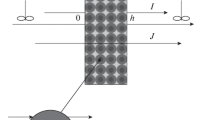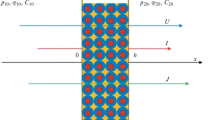Summary
The bi-ionic potentials, B. I. P.'s, arising in cells of the type: A+L−c1| liquid anion exchanger membrane of extreme anionic selectivity| A+M−c1, are surveyed briefly but systematically. The membranes consisted of trioctyl-propyl ammonium salts dissolved ino-dichlorobenzene. As anticipated on the basis of previous theoretical and experimental work on porous membranes, the following regularities were observed. The B.I.P. arising with any pair of critical ions is essentially independent of the activity of the aqueous electrolytic solutions used, and is essentially independent of the degree of loading of the membrane with ion-exchanger compound. The B.I.P.'s are higher the farther apart the two critical anions under consideration, L− and M−, are in the Hofmeister The B.I.P.'s, as shown in a series of 21 cells with seven different univalent critical ions are algebraically additive, in the sense that within the limits of the experimental error
where L−, M−, and N− represent any arbitrary combination of the anions used.
Similar content being viewed by others
References
Botrè, C., Scibona, G. 1962. Osservazioni su comportamento electrochimico di soluzioni organiche di sali di trialchilammine alifatiche.Ann. Chim. 52:1199.
Danesi, P. R., Salvemini, F., Scibona, G., Scuppa, B. 1971. Electrochemical behavior of liquid anion membranes. Biionic potentials with the NO −3 −Cl−, NO −3 −Br−, Br−−CL− couples.J. Phys. Chem. 75:554.
Dray, S., Sollner, K. 1955. Experimental studies on bi-ionic potentials across permselective membranes.Biochim. Biophys. Acta 18:341.
Dray, S., Sollner, K. 1956a. A theory of dynamic polyionic potentials across membranes of ideal ionic selectivity.Biochim. Biophys. Acta 21:126.
Dray, S., Sollner, K. 1956b. An experimental test in two-ionic systems with permselective membranes of the theory of dynamic polyionic potentials across membranes of ideal ionic selectivity.Biochim. Biophys. Acta 21:213.
Hale, D. K., Govindan, K. P. 1969. Bi-ionic potentials with sulfonic and phosphonic acid cation-exchange membranes.J. Electrochem. Soc. 116:1373.
Shean, G. M., Sollner, K. 1966. Carrier mechanisms in the movement of ions across porous and liquid ion exchanger membranes.Ann. N.Y. Acad. Sci. 137:759.
Sollner, K. 1949. The origin of bi-ionic potentials across porous membranes of high ionic selectivity.J. Phys. Colloid Chem. 53:Pt. I, 1211; Pt. II, 1226.
Sollner, K. 1971. The basic electrochemistry of liquid membranes.In: Diffusion Processes, Proceedings of the Thomas Graham Symposium. J. N. Sherwood, A. V. Chadwick, W. M. Muir, and F. L. Swington, editors. Vol. 2, p. 655. Gordon and Breach, London.
Sollner, K., Shean, G. M. 1964. Liquid ion-exchange membranes of extreme selectivity and high permeability for anions.J. Amer. Chem. Soc. 86:1901.
Sollner, K., Shean, G. M. 1967. Liquid ion exchange membranes of extreme ionic selectivity and high transmissivity.Protoplasma 63:174.
Author information
Authors and Affiliations
Rights and permissions
About this article
Cite this article
Shean, G., Sollner, K. Bi-ionic potentials across liquid anion exchanger membranes. J. Membrain Biol. 9, 297–304 (1972). https://doi.org/10.1007/BF01868058
Received:
Issue Date:
DOI: https://doi.org/10.1007/BF01868058




